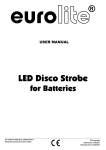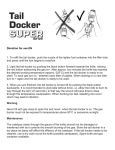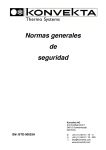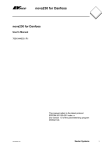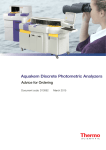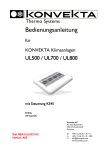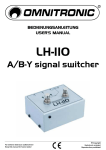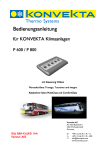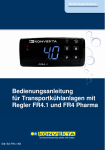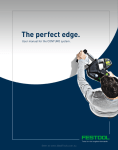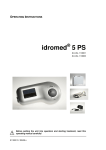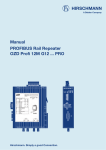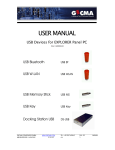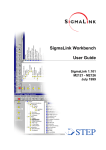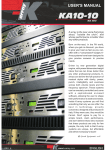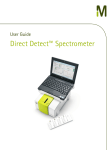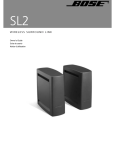Download 1 Allgemeine Sicherheitsvorschriften_neu_Einbaurichtlinien.qxd
Transcript
Installation guidelines 1. Safety regulations 1.1.1. Foreword Work with machinery involves dangers to life or physical injury which you as an operator, driver or servicing technician can come across. If you always carefully read and observe the various safety instructions, you can avoid dangers and accidents. This especially applies to staff members who only use the machine occasionally, such as for servicing. The following safety regulations guarantee your safety, the safety of others and help avoid of damages to the machine when followed carefully. 1.1.2. General safety regulations • Make yourself familiar with the operating and servicing instructions before starting up the machine. • Make sure that you possess any possible additional instructions for your version of the machine and that you have read and understood them. • Only authorised persons are permitted to operate, service or repair the machine. Observe the legal minimum age. • Only deploy trained and instructed personnel and clearly define the areas of responsibility of staff members for operating and servicing work. • Define the areas of operator responsibility (including with respect to legal traffic regulations) and allow him to refuse to follow instructions from third parties which contradict safety. • Only allow employees who are being trained, taught, instructed or who are undertaking an apprenticeship scheme to work under the supervision of experienced and authorised personnel. • Occasionally check whether staff members are working with attention to safety and dangers and are observing the operating and servicing manuals. • Wear safety clothing when working on or with the machine. Avoid wearing rings, watches, ties, scarves, open jackets and loose clothing. These can get caught or pulled in which poses a danger of injury. Certain work requires the following: protective eyewear, safety shoes, protective helmet, working gloves, reflective vest, ear protectors or respiratory protection equipment. • Inform yourself about the valid safety regulations on site and make yourself familiar with them. • Never start up a machine (or vehicle) without having thoroughly inspecting it beforehand and checking whether warning signs are missing or are illegible. • The machine must be provided with specific safety devices for special applications. In this case, work is only permitted once these are attached and fully functional. • Do not perform any changes, attachments or conversions to the machine which might affect safety without the permission of the supplier. This is particularly valid for the installation and setting of safety devices and valves or for welding weight-bearing parts 1 Pay attention to all danger and safety information • Equipment or attached parts from other manufacturers or ones which KONVEKTA have not approved may not be installed or applied to the machine without the written permission of KONVEKTA. KONVEKTA will provide the necessary technical documents. 1.1.3. Avoiding crushing and burns • Do not work under the machine or the vehicle if it is not safely positioned on the ground, supported or sufficiently protected against falling or dropping. • Do not use any damaged lifting aids such ropes or chains and do not use aids without the necessary load capacity. Wear protective work gloves when handling metal chains. • If the vehicle engine is running or a machine is in operation, make sure that no objects can enter the fan. The fan will launch these objects away and be damaged by the objects. • The engine cooling system and lines and tubes which conduct refrigerants fluids are hot and pressurised when close to operational temperature. Avoid contact with parts which conduct cold water and refrigerants. There is a danger of burning. • Avoid work in the engine area when the vehicle engine is running. There is a danger of getting caught or pulled in, crushing and burns. • Always start the machine according to the regulations mentioned in the operating and instruction manual. • Check the electrical unit regularly. Let all faults such as loose connections, blown fuses and lamps and charred or scuffed cables be corrected by a specialist. • Let all lines, tubes and screw joints be checked for leaks and damages by a specialist. Repair any leaks immediately and replace all damaged parts. • Become familiar with the use of fire extinguishers and inform yourself about the local fire brigade, fire fighting options and any regulations. 1.1.4. Safety information for initialisation • Carry out a thorough inspection on the machine before each initialisation. • Check the machine and all associated additional components such as condenser fixings and operator elements for loose parts, wear and tear, splits, leaks and wilful damages. • Never take a defective machine into operation. Make sure that damages are repaired immediately. • Make sure that all hoods, covers and protectors are closed and locked that all warning signs are present. • Make sure that you can recognise and read all operator and display elements at all times. Protect displays and other display devices from sunlight and other visual disturbances. • Make sure that no one is working on, with or under the vehicle/machine and warn people in the surrounding 2 Installation guidelines area before initialising the machine. 1.1.5. Safety regulations for starting the machine • Check the function of all warning lamps and instruments before starting the vehicle/machine and set all operator elements on the machine to the neutral position. • Before starting the machine/vehicle sound the horn briefly to warn people in the vicinity of the vehicle/machine. • Only start the machine from the driver or operator station. • If you do not receive any other instructions start the machine according to the instructions in the operating and user manual. • Only allow combustion engines to run in enclosed spaces if there is sufficient ventilation. Open windows and doors where necessary to guarantee the supply of fresh air (according to the “technical regulations for dangerous substances”, TRGS 554, volume 1, part 6, chapter 11, section 4.7.4.1 to 4.7.6). • Check the function of the machine’s controls. 1.1.6. Information for safe working processes • Make yourself familiar with the specific conditions in the surroundings, special valid regulations and any possible warning signals before starting any work on or with the machine. The working environment includes obstacles in the working and transport areas, the load capacity of the floor and the necessary protection of the site from public transport areas. • Report any functional faults and make sure that all necessary repairs are carried out immediately. • Ensure that no one is in danger when the machine is taken into operation. 1.1.7. Turning the machine off safely • Switch off the machine/vehicle engine according to the instructions provided in the operating and user manual and set all operator elements to the neutral position. Lock the vehicle correctly, remove the key from the ignition and secure the machine against unauthorised use and vandalism. 1.1.8. Transporting the machine safely • Only use suitable transport equipment and lifting equipment with sufficient weight bearing capacity. • Do not try to lift heavy parts but use suitable lifting aids with sufficient weight bearing capacity. Secure individual parts and larger components carefully to lifting equipment when exchanging them to avoid any danger. • Only use suitable lifting equipment which is in a perfect condition and lifting aids with sufficient weight bearing capacity. Do not stand under suspended loads and avoid working under suspended loads. • Do not use any lifting equipment or aids which are damaged or do not have sufficient capacity. Wear protec- tive work gloves when handling steel ropes and chains. • Only deploy experienced personnel to attach the loads and to instruct the crane and fork-lift truck drivers. • The instructor must remain in sight of the operator or be able to communicate with him. 1.1.9. Measures for safe servicing • Do not carry out any servicing work or repairs which you are not capable of. • Adhere to the periods stated in the stipulated in the operating or service manual for repeated tests/inspections. Sufficient workshop equipment is necessary for the work involved in servicing. • All work or interference with the cooling system and all components which conduct refrigerant may only be carried out by suitable, qualified and trained specialists (cooling system engineer, vehicle electrician). • Replacement parts must correspond to the technical requirements designated by KONVEKTA. This is always guaranteed if original KONVEKTA replacement parts are used. • Always wear safety clothing for servicing work. Apart from safety shoes and work gloves, some work requires a protective helmet, protective face mask, ear protectors or protective respiratory equipment. • Keep unauthorised persons away from the machine/vehicle during servicing work. • Secure the servicing area with a much clearance space as necessary. • Inform the operating personnel before carrying out any specific work or servicing work. Designate a supervisor. • When undertaking any servicing or repair work, make sure that any loosened screws are retightened according to the stipulated torque level. • If safety devices must be dismantled for servicing or repairs, the safety devices must be remounted and chekked immediately after completion of servicing or repair work. • For servicing work (especially inside the engine) hang a warning sign with “do not switch on” on the ignition and remove the ignition key. • Clean the machine (especially any connections or screw joints) of oil, fuel or protective products at the beginning of the repair/service. Do not use strong cleaning products and use non-fibrous cloths. • Do not use any flammable cleaning fluids to clean the machine. • Before cleaning the machine with water, steam (pressurised steam cleaner) or other cleaning agents, cover or seal all openings in the machine into which water/steam/cleaning agents may not enter due to safety or functional reasons. Electrical engines, switch and operator elements, plug connections and heat exchangers are at particular risk. Make sure that all covers and seals are removed after cleaning work is completed. Inspect all fuel, engine oil, and hydraulic oil and refrigerant lines after cleaning work for leaks, loose connections, scuffs and damages. Installation guidelines • Allow any defects to be repaired immediately. • Do not use any strong cleaning agents to clean the machine or any steam cleaners within the first two months after initial use or after repainting. • Only carry out welding, cauterisation or grinding on the machine when permitted in writing by KONVEKTA. Clean the machine/vehicle and the surrounding area of dust and flammable substances before carrying out any welding, cauterisation or grinding work. Ensure that there is sufficient ventilation. There is a danger of fire and/or explosion. • Observe the valid safety regulations for the respective product with regard to handling oils, fats and other chemical substances. Make sure that substances, aids and replaced parts are disposed of safely in an environmentally-safe way. • Handle hot substances and aids carefully. There is a danger of burning or scalding. • Only operate combustion engines in sufficiently ventilated spaces. Make sure that there is sufficient ventilation in enclosed rooms when starting the engine. • Follow the instructions and safety regulations which are valid for the respective site. • Use safety equipment, climbing aids and working platforms for assembly work above head height. • Do not use any machines or vehicle parts as climbing aids which are not intended to be used to climb on. • Wear fall arrest equipment for servicing work at a height. Keep all handles, steps, railings, podiums, platforms, ladders and other climbing aids free of dirt, snow and ice. 1.1.10. Safe servicing of refrigerant and hydraulic tubes. • All tubes, pipelines and screw joints must be checked regularly (at least once per year) for leaks and any recognisable external damages. • Repair any damaged parts immediately. • Squirting oil or refrigerant can lead to injury or fire. • Tubes and pipelines are subject to normal wear and tear even if they are stored and used correctly. The period of use is therefore limited. • Incorrect storage, mechanical damages and unauthorised excessive use are the main causes of failure. • The period of use of a hydraulic pipeline should not exceed six years including a storage period of a maximum two years (observe the manufacture date on the tubes). • Repairs on hydraulic tubes and pipelines are forbidden! • If the maximum limit range for strain on the pipelines is applied, this can reduce the lifespan (e.g. high temperatures, frequent movements, high impulse frequencies or use over several shifts). • Tube and pipelines must be replaced when the following criteria are found during inspections: • Damages to the outer layer down to the insert (e.g. scuffing, cuts or splits). • The outer layer is brittle (splits in the tube material), there are deformations which do not correspond with the natural shape of the tube both when pressurised and • • • • • • • 3 depressurised or bends e.g. separation of layers and build up of air bubbles. Leaks. Failure to comply with the requirements for installation. Damages or deformation of the tube fittings which reduce the stability of the fitting or the connection between tube and fitting. The tube loosens from the fitting. The fitting is corroded and it affects the function and stability. Excessive storage periods and period of use. Lay and mount tubes and pipelines correctly and do not mix the connections up. 1.2. Explanation of abbreviations for KONVEKTA products The names of KONVEKTA products are mainly technical abbreviations. In addition to the common abbreviations for electrical units, power consumption and dimensions etc, KONVEKTA has developed its own system for abbreviations which we will explain and present in the following. Module types: KL - Air-conditioning unit which can also in clude heating HLK, HKL - Air-conditioning units which heat, venti late (fresh air) and cool. FK - Fresh service units TK - Deep freeze units TKH - Deep freeze units with hydraulic drive TKD - Deep freeze units with diesel engine drive VD - Vaporiser KD - Condenser UKD - Underfloor condenser DKD - Roof condenser HKD - Rear condenser Numbers: The KL and HKL air-conditioning units (HLK units are an exception) are numbered from KL1 to KL12 and a KL2 unit has a lower power output than a KL3. An additional 0 is added to the new generation of KL units; i.e. KL60 or KL70. The FK & TK units have a higher number code i.e. FK2250. This number identifies the cooling power for a standard temperature of 30°C outside and 0°C inside. The unit identification (e.g. KL6) is following by letters such as KL6AFT for example. The meaning of the letters is explained as follows: Type of construction: A stands for F stands for R stands for KL6ART on the roof flat construction round and flat construc tion Installation guidelines 4 T stands for C stands for (KL6AFT) stands for Split stands for 2VD 4VD T/N stands for stands for stands for tropical use which means up to 55°C outside temperature. For units without “T”, the perfor mance level is up to 38°C. (such as KL6CFT) a special value which usually has less output than the normal version. integrated with a unit which is fully integrated in the vehicle. split unit components whereby the KD is usually outside and the vaporiser(s) is/are usually ar ranged inside. a double vaporiser version. a quadruple vaporiser version. day/night which occurs on FK & TK units and means that a night rate with 220V or 380V is integra ted. 1.3. Installation guidelines for Konvekta units All air-conditioning units or cooling systems which are produced and sold by KONVEKTA are equipped with specific “lifting points or hanging points”. These points must be used to lift or transport the unit when it is to be mounted to avoid the unit twisting. The twisting of the unit due to incorrect transport aids can lead to damages (splits or leaks) on the unit which are noticed when the unit is taken into operation, especially on busses. The lifting device must be produced by the installer and must meet the guidelines for lifting equipment. When producing such lifting devices, the weight of the unit must be considered (correct selection of material). Due to the fact that units made by KONVEKTA have various sizes and weights, the lifting points on the individual units are different and a universal lifting device cannot be used. The transport and mounting of KONVEKTA units on a fork-lift truck is objected to by KONVEKTA and does not comply with the safety regulations. Any damages which are traced back to this kind of transport will not be acknowledged by KONVEKTA in a GWA and results in a negative GWA assessment. The standard safety regulations for cranes must be complied with.




